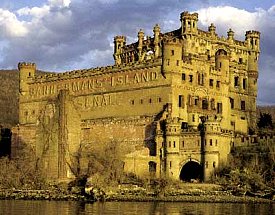Sign up today to get your FREE newsletter and BONUS info!
Take a Hudson Valley Motorcycle Ride...
Check Out Bannerman Castle
Perched in the Hudson River

During a Hudson Valley motorcycle ride, I first saw Bannerman Castle. This fortress resembles a monstrous chess piece perched a small island in the Hudson River.
The castle was once an arsenal containing a huge inventory of military weapons, equipment and explosives.
Now it is deserted, vine covered and dangerously fragile.
This giant fortress dominates a small island
When motorcycle riders want to escape the confines of the New York-New Jersey metropolitan area, they often take a Hudson Valley motorcycle ride by following the Hudson River north into Rockland, Orange, Westchester and Putman counties.
The lower Hudson valley offers a great mix of twisty, hilly, two-lane back roads that share the woodlands and rocky lake country with the Appalachian Trail.
On both sides of the river, two- and four-lane routes follow the Hudson’s sweeping contours through the highlands and past Revolutionary War battlefields and many other historic sites.
Route 9W, Route 6 and the Palisades Interstate Parkway merge in the hills above the Hudson’s west bank near Bear Mountain Bridge.
For those who have never ridden across this span, just passing through its storybook tollbooth is worth the $.75 -- at least once. On the other side, travelers can turn left and head north along scenic Route 9D as it follows the Hudson’s eastern shore.
As part of the Hudson River Greenway Trail from Bear Mountain Bridge to Beacon, the two-lane Route 9D is a fun Hudson Valley motorcycle ride that’s full of interesting sights and places to stop -- natural and manmade.
I thought I had seen them all during my numerous Hudson valley motorcycle trips. But, I recently learned that the steep embankments and woods along 9D about 12 miles north of the bridge hide one of the most startling landmarks in the lower Hudson River valley.
A castle for an arsenal
The dark, vine-covered remains of a massive fortress called Bannerman Castle dominate a small, rocky island a few hundred yards from the Hudson’s eastern shore.
Frank Bannerman VI built this edifice in the early 1900s -- not as a home, but as an arsenal for his immense collection of surplus military weapons and equipment purchased from counties around the world.
Frank Bannerman has been called the “Father of the Army and Navy Store.”
At one time, his company was the world’s largest commercial buyer and seller of surplus military equipment ranging from cannons and gunpowder to bayonets and scabbards to hats and boots.
The business was immense. For example, at the close of the Spanish American War, Bannerman purchased 90 percent of all captured equipment.
During the Russian-Japanese war, he filled an order for 100,000 saddles, rifles, knapsacks, haversacks, gun slings, uniforms and 20 million cartridges, plus a shipload of other assorted military goods.
Cities throughout the United States purchased cannons and artillery pieces from Bannerman’s company, and then placed them in town parks as monuments commemorating our armed forces.
Didn’t you ever wonder where that cannon in the park came from?
Bannerman eventually needed a new, more secure place to store his extensive inventory -- especially the huge quantities of volatile black powder and assorted cartridges and artillery rounds.
In 1900, he purchased Pollipell Island in the Hudson about 35 miles north of Manhattan. He then spent the next 17 years building Bannerman Castle.
Bannerman’s Scottish heritage shines through
Bannerman personally designed the island’s buildings, docks, turrets, garden walls and moat in the style of old Scottish castles. In addition to warehouse space, Bannerman built a home on the island.
Unique decorative touches throughout included biblical quotations cast into fireplace mantles, and a shield between the castle towers bearing a coat of arms embossed with a wreath of thistle, leaves and flowers.
Historic artifacts tucked away included a table owned by General Washington and expedition equipment used by Admiral Perry on his trip to the North Pole.
The Bannerman Castle can be seen best when traveling by boat on the river or along the train tracks that parallel the riverbank. On the north and east sides of the warehouse, 4 1/2-foot high letters cast in concrete read “Bannerman Island Arsenal.”
In 1967, the Bannerman family sold the castle to New York State, which took possession after the Bannerman family removed the remaining military gear and gave many historic relics to the Smithsonian.
Fire destroys the castle
The state planned to open the castle and grounds as a park, but on August 9, 1969, a fire of unknown origin gutted and severely damaged the fortress and other buildings.
Since then, the parks commission has declared the island and castle off-limits to the public.
During the late fall, I took a Hudson Valley motorcycle ride up 9D to see the castle for myself. A few miles north of Cold Spring, I spotted the pedestrian overpass at Metro North’s Breakneck Ridge train stop.
After parking the bike in a dirt lot on the east side of the road just south of the overpass, I walked about 1/16-mile up the road. A steep path up the embankment goes into the woods and leads to the overpass.
My first impression during this Hudson Valley motorcycle ride
I topped the embankment, cleared the trees and looked north out into the river. And there stood the ruins of Bannerman Castle.
My first impression was that it looks like a giant, ornately carved chess piece misplaced on a tree-covered island.
While generally rectangular, the castle is replete with curved spires, turrets and alcoves. There are no right angles. From a distance, it has the rippling, textured look of corduroy.
Through the bare trees, I could make out other smaller buildings near the water’s edge and on top of the island’s gradually sloping hill.
A turret-like structure marked the outer edge of a small harbor, and two more like it sat in the water just off the west bank.
The whole scene, even on a bright sunny day, was like an apparition. After all, this is the Hudson River in New York, not Loch Ness in Scotland.
I can only imagine how imposing and otherworldly Bannerman Castle must appear when seen close up through the fog and rain from a boat on the river rather than through the trees during a Hudson Valley motorcycle ride.
The Bannerman Castle Trust was formed to preserve the remaining structures on the island through a combination of volunteerism and fund raising.
Perhaps, someday, the group can return this amazing fortress to its original condition and New York will open it again for all to visit.
*****
Do You Enjoy Motorcycle Stories?
You can find a nice variety of motorcycle travel, adventure and riding stories in my "Ten for the Road" series of books.
Click here to zero-in on three collections of motorcycle stories for your reading pleasure…
Tell Us Your Motorcycle Riding Story
Share with us your motorcycle story -- or stories -- about a terrific ride, great destination or lessons learned...
Return from Bannerman Castle to the main
Let's stay in touch!
Get your free subscription to..."Savvy Motorcyclist E-zine"
And you'll also receive your free copies of...“The 10 Best Motorcycle Travel and Trip Planning Websites on the Internet” ... plus the Motorcycle Safety Foundation’s 58-page Motorcycle Operator’s Manual.
These great resources will help you to ride better, plan your trips, enjoy the best motorcycle roads and get the most out of motorcycle riding.

